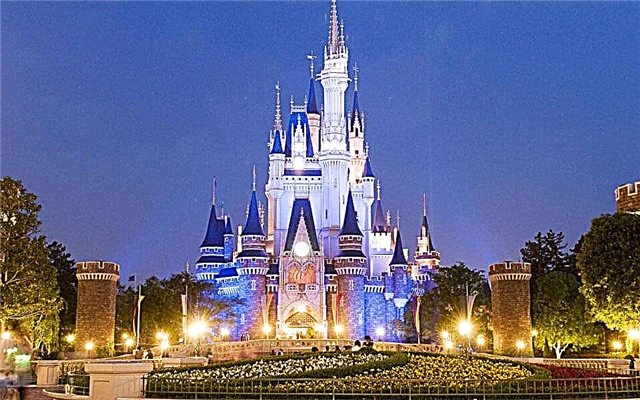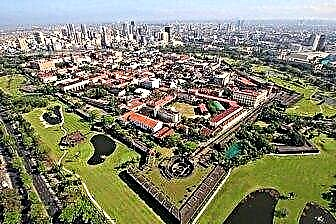Address: Russia, St. Petersburg, Ligovsky prospect, 128
Building: 1748 - 1749
Architect: name not known
Coordinates: 59 ° 54'58.4 "N 30 ° 21'12.7" E
Object of cultural heritage of the peoples of the Russian Federation
Content:
In the historical center of the city there is one of the most beautiful cathedrals and temples of St. Petersburg - a baroque church dedicated to the Exaltation of the Holy Cross. It appeared in the 18th century in the old Yamskaya Sloboda. Today the cathedral complex consists of three Orthodox churches and auxiliary buildings.

General view of the complex of the parish of the Holy Cross Cossack Cathedral
Precursor temples
In the first half of the 18th century, St. Petersburg was a very small city. On the site of the modern Ligovsky Prospect, the road to Novgorod ran - the only road that connected the banks of the Neva with Russia. Families of coachmen lived next to the carriageway, and gradually the Yamskaya Sloboda was formed here.
Orthodox Christians did not have their own church, so in 1710 they built a small chapel in the local cemetery. True, three years later the wooden building burned down during a fire.
The coachmen raised funds, drew up a petition and in 1718, after the permission of the archimandrite, erected a small church on the churchyard in honor of the Nativity of John the Baptist. The one-story temple looked very modest. The elongated building had a high sloping roof and a narrow spire with a cross.

View of the Holy Cross Cathedral
After a while, a wooden belfry appeared nearby, but there were no bells for it. These were the years when, by order of Peter the Great, "extra" bells from Russian monasteries were brought to St. Petersburg and cannons were cast from them. The four bells were not given to the foundry workers, but were hung on the new bell tower.
Another fire broke out in 1730. The raging fire burned the wooden temple to the ground. The crushed parishioners raised money and bought the old chapel at the Okhta factories. So another wooden temple appeared on the ashes.
Unfortunately, his age was not long. The wooden building quickly fell into disrepair. After a few years, the walls were dilapidated, and the roof began to leak in the rain. The distressed parishioners of the Yamshitskaya Sloboda drew up a new petition to the diocese and asked for permission to build a stone church.

Facade of the Holy Cross Cathedral
The history of the cathedral in the 18th-19th centuries
Bureaucracy in Russia has been strong at all times. It took more than 15 years for various approvals and collection of the necessary funds. The construction itself took two years.
History has not preserved the name of the author of the project, but according to documents it is known that the workers were led by the German architect Johann Jacob Schumacher. He was an experienced architect who had already erected several civil buildings and churches in St. Petersburg. In 1749, the new temple was ready, and it was consecrated in honor of the Feast of the Exaltation of the Holy Cross.
In the 60s of the 18th century, a warm church of the Tikhvin Icon of the Mother of God appeared nearby. It was built with the money of the merchant I. Ilyin.
At the beginning of the 19th century, the architect Alexander Ivanovich Postnikov prepared a project for a high bell tower. By 1812, construction was completed. In front of the two temples, a four-level gate tower with a spire appeared, and it immediately became the architectural dominant of the city.

Bell tower of the Holy Cross Cathedral
In the 1850s, the cathedral experienced a rebirth. The talented architect Yegor Ivanovich Dimmert completely rebuilt the building in the best neo-baroque traditions. At the same time, it preserved part of the walls and foundations of the stone church of the 18th century. The stucco work for the renovated cathedral was performed by the skilled craftsman Timofey Dylev, and the icons were painted by the iconographer Korotkov.
Since 1856, for 18 years, the well-known educator and teacher Ioann Konstantinovich Yakhontov was the rector of the church. Thanks to his efforts and the sponsorship of the merchant I.I.Shigalev, the church of Cyril and Methodius appeared under the arches of the church bell tower. The architectural project for a small church was prepared by Ludwig Fedorovich Bulieri.
Saint Petersburg grew and expanded from year to year. Ligovskaya side was not a suburb for a long time, and the name "Yamskaya Sloboda" remained only in the memory of historians. The inhabitants of Ligovka and the Cossacks, who carried out military service in the city, came to the temple to pray.
At the turn of the 19th and 20th centuries, the parish of the cathedral was one of the largest in the diocese. It numbered over 14 thousand people. At the temple there was a Society for the Aid to the Poor, an almshouse for elderly women, a free canteen, an orphanage for children and a parish school.

The fate of the temple in the XX century
After the revolution, the cathedral was not closed immediately. Divine services continued until the early 1930s, when mass persecution of believers began in the country. First, the city authorities liquidated the Tikhvin Church. The cult building was given over to a school. Then production workshops were created here, and part of the premises went to the radio technical school.
In 1938 it was the turn of the Holy Cross Church. During the repressions, eight priests were shot, and the cathedral was closed to parishioners for a long time. The building was converted into a film storage. New warehouse floors and cross-members have significantly distorted the interiors and disfigured the temple.
Then the war began. During the shelling of Leningrad, several shells hit the cathedral. However, this was not the only problem. In the first winter of the blockade, the bodies of Leningraders who died of starvation were taken to the church. They were not buried because it was extremely cold. Only in the spring of 1942, the dead residents of the city received their last shelter at the Volkovskoye cemetery.
After the war, restoration workshops were housed in the cathedral. For several years, there were heavy woodworking and turning machines inside. The floor was covered with a thick layer of asphalt, there was a bathhouse in the vestibule, and workers were undressing in the altar.

Sculptures of the apostles Paul and Peter in the niches of the cathedral bell tower
In 1991, the old building was handed over to the Cossack parish of the city. According to the documents, the condition of the temple was assessed as "ruins". It looked like a huge barn with half-collapsed plaster.
First, it was necessary to remove the territory from garbage and collect money for construction materials. The first service was held in 1993. Large-scale restoration of all church buildings took over 10 years.
Architectural features
The entrance to the territory of the cathedral complex is from the side of Ligovsky Prospect. Tourists and pilgrims are greeted by a slender bell tower with a spire. It rises to 60 m, and therefore is clearly visible from the adjacent quarters.
Two arched spans with twin columns connect the bell tower with low chapels. Sculptural images of the apostles Paul and Peter are installed in the niches. Above, you can also see eight statues of the apostles.

Cathedral domes
The central place is occupied by the old Cathedral of the Exaltation of the Cross. The baroque Orthodox church looks very festive. This is how they built in Russia during the reign of Empress Anna Ioannovna.
The temple has the shape of a Latin cross and a semicircular apse. The building is 53 m long and 35 m wide. Together with the cross, the cathedral rises 41 m. Five expressive baroque chapters rest on large light drums.
Interiors and shrines
The interior of the cathedral is spacious and light. The walls and ceilings are covered with paintings depicting scenes from the Holy Scriptures and the faces of saints. The northern side-altar of the temple is dedicated to Prince Alexander Nevsky, and the southern side - to the Holy Royal Martyrs.

Church of the Tikhvin Icon of the Mother of God
There are many icons in the cathedral. Parishioners venerate military relics - the ancient image of the Great Martyr George, the banner of the Cossack brotherhood, the Imperial flag and the banners of the Don and Kuban troops.
A special shrine is the icon of the Tikhvin Mother of God, painted in the middle of the 19th century. The beautiful icon case is adorned with an embroidered robe and jewels donated by the faithful.Many come to pray near the reliquary where the relics of Christian saints, apostles and martyrs for the faith are kept.
Useful information for visitors
The Cathedral of the Exaltation of the Cross is open every day from 9:00 to 20:00. You can get to the Tikhvin Church only during services. The Church of Cyril and Methodius is available during the warmer months. The chapel on Ligovsky Prospekt is open from 10:00 to 14:00 and from 15:00 to 19:00. Church services are held at 10:00 and 17:00.
In the fence of the cathedral from 10:00 to 19:00 a shop is open, where they sell honey, medicinal herbs and tinctures. For pilgrims, tours of the parish churches are conducted.

Monument to the Holy Martyr Tsar Nicholas II and his family on the territory of the parish of the Holy Cross Cossack Cathedral
How to get there
The temple is located near the embankment of the Obvodny Canal, at Ligovsky Prospect, 128. It is easy to walk to it from the Obvodny Canal metro station.











